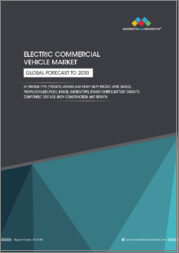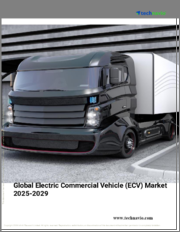
|
시장보고서
상품코드
1385532
전기 상용차 활성화를 위한 지역 규제 및 정책 분석 분석Analysis of Regional Policies and Regulations in Support of Electric Commercial Vehicles |
||||||
전기 트럭·버스 도입에 대한 인센티브 증가로 미래 성장 가능성 높아질 것
전 세계적으로 보조금, 세금 감면 또는 내연기관차(ICE) 관련 벌칙의 형태로 전기 트럭 및 버스 구매에 대한 인센티브는 전기차(EV)의 구매 비용을 크게 낮춰 차량에 대한 전기차(EV)의 매력을 높이는 데 큰 도움이 됩니다. 또한, 인센티브는 EV를 생산하는 주문자상표부착생산자(OEM)가 EV 생태계에 대한 투자를 늘리고 생산 규모를 확대할 수 있는 동기를 부여하여 궁극적으로 비용 절감에 기여할 수 있습니다.
차량들은 대체 파워트레인 차량을 구매할 때 총소유비용을 고려해야 합니다. 비용을 더 낮출 수 있는 인센티브를 추구해야 합니다. 공급업체 측의 크레딧과 OEM에 대한 탄소세는 청정 에너지 차량, 특히 운송 산업에서 탄소 배출의 대부분을 차지하는 상업용 차량의 생산을 늘리는 중요한 원동력이 될 것입니다.
EV 충전 인프라 시설 설치에 대한 정부 인센티브는 공공 충전과 충전소 기반 충전 모두 충전 생태계의 확장 및 확장을 지원하여 EV의 보급을 지원합니다. 충전 인프라 설치에는 충전 장비 제조업체, 충전소 운영사, 차량 및 충전 소프트웨어 회사, 에너지 사업자 등 다양한 플레이어로 구성된 더 큰 생태계가 관련되어 있습니다.
차량들은 충전 인프라 설치에 대한 지원만 있다면 전기 트럭과 버스를 도입할 인센티브가 증가하고 있으며, 많은 OEM 업체들이 충전 장비 제조업체 및 전력 회사와 협력하여 이러한 측면의 추가 서비스를 제공하고 있습니다. 많은 신규 업체들이 장비와 소프트웨어를 통해 전기 충전 인프라 분야에 진입하고 있으며, 이로 인해 진입 범위와 창출 가치가 확대되고 있습니다.
이 세계 전기 상용차 산업 분석은 2022년부터 2030년까지를 조사 기간으로 삼았습니다. 대상 지역은 북미(캐나다, 미국), 유럽(프랑스, 독일, 이탈리아, 스페인, 영국, 노르웨이, 네덜란드, 벨기에, 폴란드, 덴마크, 스웨덴, 스위스, 핀란드, 오스트리아), 중국, 인도입니다.
목차
전략적 과제
- 왜 성장이 어려워지고 있는가?
- The Strategic Imperative 8(TM)
- 전기 상용차(CV) 업계의 주요 전략적 원칙의 영향
- 성장 기회가 Growth Pipeline Engine(TM)을 촉진
성장 기회 분석
- 전기 CV 호감도
조사 범위와 세분화
- 조사 범위
- 세분화
프랑스 - 인센티브와 세제 우대조치 개요
- EV 인센티브와 세제 - 프랑스
- EV 인프라 인센티브 - 프랑스
독일 - 인센티브와 세제 우대조치 개요
- EV 인센티브와 세제 - 독일
- EV 인프라 인센티브 - 독일
이탈리아 - 인센티브와 세제 우대조치 개요
- EV 인센티브와 세제 - 이탈리아
- EV 인프라 인센티브 - 이탈리아
스페인 - 인센티브와 세제 우대조치 개요
- EV 인센티브와 세제 - 스페인
- EV 인프라 인센티브 - 스페인
영국 - 인센티브와 세제 우대조치 개요
- EV 인센티브와 세제 - 영국
- EV 인프라 인센티브 - 영국
노르웨이 - 인센티브와 세제 우대조치 개요
- EV 인센티브와 세제 - 노르웨이
- EV 인프라 인센티브 - 노르웨이
네덜란드 - 인센티브와 세제 우대조치 개요
- EV 인센티브와 세제 - 네덜란드
- EV 인프라 인센티브 - 네덜란드
벨기에 - 인센티브와 세제 우대조치 개요
- EV 인센티브와 세제 - 벨기에
- EV 인프라 인센티브 - 벨기에
폴란드 - 인센티브와 세제 우대조치 개요
- EV 인센티브와 세제 - 폴란드
- EV 인프라 인센티브 - 폴란드
덴마크 - 인센티브와 세제 우대조치 개요
- EV 인센티브와 세제 - 덴마크
- EV 인프라 인센티브 - 덴마크
스웨덴 - 인센티브와 세제 우대조치 개요
- EV 인센티브와 세제 - 스웨덴
- EV 인프라 인센티브 - 스웨덴
스위스 - 인센티브와 세제 우대조치 개요
- EV 인센티브와 세제 - 스위스
- EV 인프라 인센티브 - 스위스
핀란드 - 인센티브와 세제 우대조치 개요
- EV 인센티브와 세제 - 핀란드
- EV 인프라 인센티브 - 핀란드
오스트리아 - 인센티브와 세제 우대조치 개요
- EV 인센티브와 세제 - 오스트리아
- EV 인프라 인센티브 - 오스트리아
미국 - 인센티브와 세제 우대조치 개요
- EV 인센티브와 세제 - 미국
- EV 인프라 인센티브 - 미국
캐나다 - 인센티브와 세제 우대조치 개요
- EV 인센티브와 세제 - 캐나다
- EV 인프라 인센티브 - 캐나다
중국 - 인센티브와 세제 우대조치 개요
- EV 인센티브와 세제 - 중국
- EV 인프라 인센티브 - 중국
인도 - 인센티브와 세제 우대조치 개요
- EV 인센티브와 세제 - 인도
- EV 인프라 인센티브 - 인도
성장 기회 유니버스
- 성장 기회 1 - EV의 경제성 향상
- 성장 기회 2 - 충전 인프라에 대한 지원 확대
- 성장 기회 3 - 정부 의무화와 기업 목표가 전기 파워트레인 채용을 촉진
- 면책사항
Incentives Targeting the Adoption of Electric Trucks and Buses Set to Increase and Boost Future Growth Potential
Globally, incentives to purchase electric trucks and buses in the form of subsidies, tax cuts, or even penalties related to internal combustion engine (ICE) vehicles can go a long way in making electric vehicles (EVs) attractive to fleets by considerably lowering the acquisition cost. Incentives also give original equipment manufacturers (OEMs) producing EVs a boost toward investing more in the EV ecosystem to increase their scale of production, which eventually will contribute to lower costs.
Fleets need to consider the total cost of ownership when acquiring alternate powertrain vehicles. They must pursue incentives that will bring down costs even further. Supplier-side credits and carbon taxes on OEMs will be a key driver to increase the production of clean energy vehicles, especially commercial vehicles that make up the majority of carbon emissions in the transportation industry.
Government issued incentives to establish EV charging infrastructure facilities will support the expansion and scaling of a charging ecosystem, both public and depot-based charging, and support the proliferation of EVs. Setting up charging infrastructure involves a greater ecosystem comprised of diverse players, including charging equipment manufacturers, charge point operators, fleet and charging software companies, and energy utilities.
Fleets are more incentivized to adopt electric trucks and buses when they have added support to set up charging infrastructure. A lot of OEMs are also offering additional services on this front by linking up with charging equipment manufacturers and utility companies. Many new companies have joined the electric charging infrastructure space, either through equipment or software, which increases the scope of participation and value created.
For this analysis of the global electric commercial vehicles industry, the study period is 2022 to 2030. The regions covered include North America (Canada and the United States); Europe (France, Germany, Italy, Spain, United Kingdom, Norway, the Netherlands, Belgium, Poland, Denmark, Sweden, Switzerland, Finland, Austria); China; and India.
Table of Contents
Strategic Imperatives
- Why is it Increasingly Difficult to Grow?
- The Strategic Imperative 8™
- The Impact of the Top 3 Strategic Imperatives on the Electric Commercial Vehicle (CV) Industry
- Growth Opportunities Fuel the Growth Pipeline Engine™
Growth Opportunity Analysis
- Electric CV Favorability
Scope and Segmentation
- Research Scope
- Segmentation
France-Overview of Incentives and Taxation Benefits
- Electric Vehicle (EV) Incentives and Taxation-France
- EV Infrastructure Incentives-France
Germany-Overview of Incentives and Taxation Benefits
- EV Incentives and Taxation-Germany
- EV Infrastructure IncentivesGermany
Italy-Overview of Incentives and Taxation Benefits
- EV Incentives and Taxation-Italy
- EV Infrastructure Incentives-Italy
Spain-Overview of Incentives and Taxation Benefits
- EV Incentives and Taxation-Spain
- EV Infrastructure Incentives-Spain
United Kingdom Overview of Incentives and Taxation Benefits
- EV Incentives and Taxation-United Kingdom
- EV Infrastructure Incentives-United Kingdom
Norway-Overview of Incentives and Taxation Benefits
- EV Incentives and Taxation-Norway
- EV Infrastructure Incentives-Norway
Netherlands-Overview of Incentives and Taxation Benefits
- EV Incentives and Taxation-Netherlands
- EV Infrastructure Incentives-Netherlands
Belgium-Overview of Incentives and Taxation Benefits
- EV Incentives and Taxation-Belgium
- EV Infrastructure Incentives-Belgium
Poland-Overview of Incentives and Taxation Benefits
- EV Incentives and Taxation-Poland
- EV Infrastructure Incentives-Poland
Denmark-Overview of Incentives and Taxation Benefits
- EV Incentives and Taxation-Denmark
- EV Infrastructure Incentives-Denmark
Sweden-Overview of Incentives and Taxation Benefits
- EV Incentives and Taxation-Sweden
- EV Infrastructure Incentives-Sweden
Switzerland-Overview of Incentives and Taxation Benefits
- EV Incentives and Taxation-Switzerland
- EV Infrastructure Incentives-Switzerland
- Finland-Overview of Incentives and Taxation Benefits
- EV Incentives and Taxation-Finland
- EV Infrastructure Incentives-Finland
Austria-Overview of Incentives and Taxation Benefits
- EV Incentives and Taxation-Austria
- EV Infrastructure Incentives-Austria
United States-Overview of Incentives and Taxation Benefits
- EV Incentives and Taxation-United States
- EV Infrastructure Incentives-United States
- Canada-Overview of Incentives and Taxation Benefits
- EV Incentives and Taxation-Canada
- EV Infrastructure Incentives-Canada
China-Overview of Incentives and Taxation Benefits
- EV Incentives and Taxation-China
- EV Infrastructure Incentives-China
India-Overview of Incentives and Taxation Benefits
- EV Incentives and Taxation-India
- EV Infrastructure Incentives-India
Growth Opportunity Universe
- Growth Opportunity 1-Greater EV Affordability
- Growth Opportunity 2-Increasing Support to Charging Infrastructure
- Growth Opportunity 3-Government Mandates and Corporate Goals Expedite Electric Powertrain Adoption
- Legal Disclaimer



















